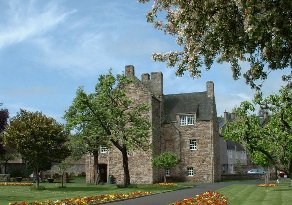|
Location In Jedburgh. |
|
 |
Mary Queen of Scots' House and Visitors' Centre |
|
October 1566 The house did not belong to Mary. The house was put at her disposal by a Thomas Ker during the stay in Jedburgh. It did not have any of the lavishness which might be associated with that of a royal residence. I think she had little choice in those days and was glad to have the house made available to her while she attended the assizes of Jedburgh and conducted other official business. The building was originally a defensive tower house, having a vaulted basement and walls eight feet thick. It was likely to have been cold and draughty and been short on creature comforts. However, Mary did have her own bedroom, and toilet, which was something. It is said that originally Mary booked in to the equivalent of an hotel in those days, but it took fire and she had to find alternative accommodation quickly. From here that she made her mammoth journey on horseback to Hermitage Castle, in Liddesdale, over dreadfully difficult terrain to comfort her lover, Bothwell, who had been injured in a fight with a reiver. She did the round trip of sixty miles in a day and nearly died of, probably, pneumonia, but whatever it was she was vomiting blood. Later, she had cause to say: "Would that I had died at Jedworth." Another version: "Would God I had died at Jeddart." Take your pick.
The house has been thoughtfully restored and is probably much as it was in Mary's time. On display are many furnishing and domestic items which were used in medieval times. Probably the most popular attraction is Mary's death mask - a genuine one. Also on display is a watch found at Queen's Mire, on the route she took when she visited l Bothwell at Hermitage. The watch was found in 1817 and had been lying there over 250 years. Another feature of popular interest is the Queen's toilet which is built into the wall. In those days inside toilets were rare and only provided for the very wealthy and for people of high rank. There was no flush system and no toilet paper. Usually sphagnum moss was provided in its place.There is a Mary Room in Drumlanrig Tower, Hawick, where she is believed to have stayed.
|
|
|
|
|